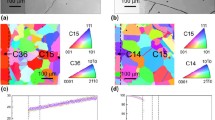Abstract
Measurements of hardness anisotropy by Knoop diamond indentation on the {100} surfaces of Nb6C5 crystals show that the hardness is determined by crystallographic slip on {111} 〈1¯10〉 and {110} 〈1¯10〉 systems. {111} is the preferred slip plane for Nb6C5 and crystals with higher carbon content which show a marked decrease in Knoop hardness. The carbon atom/vacancy arrangement in these crystals is shown, by electron diffraction, to possess short-range order. Crystals annealed at low temperatures contain domains of non-cubic long-range order which increase the Knoop hardness and eliminate the anisotropy in hardness. Dislocation arrangements around Knoop indentations have been directly observed by electron microscopy in an attempt to confirm the slip processes deduced from hardness anisotropy.
Similar content being viewed by others
References
C. A. Brookes, J. B. O'Niell andB. A. W. Redfern,Proc. Roy. Soc. (London) A322 (1971) 73.
D. J. Rowcliffe andG. E. Hollox,J. Mater. Sci. 6 (1971) 1261.
Idem, ibid 6 (1971) 1270.
W. S. Williams, Report AFML-TDR-64-25, Part II (1965)
D. J. Rowcliffe andW. J. Warren,J. Mater. Sci. 5 (1970) 345.
C. H. De Novion, R. Lorenzelli andP. Costa,Compt. Rend. Acad. Sci. (Paris) 263 (1966) 775.
J. D. Venables, D. Kahn andR. G. Lye,Phil. Mag. 18 (1968) 177.
M. H. Lewis, J. Billingham andP. S. Bell, “Electron Microscopy and Structure of Materials” (University of California Press, Berkeley, 1972) p. 1084.
J. Billingham, P. S. Bell andM. H. Lewis,Phil. Mag. 25 (1972) 661.
J. D. Venables andM. H. Meyerhoff, Proc. NBS Symposium on Novel High Temperature Materials (1972).
R. H. J. Hannink, D. L. Kohlstedt andM. J. Murray,Proc. Roy. Soc. (London) A326 (1972) 409.
J. Billingham, P. S. Bell andM. H. Lewis,Acta Cryst. A 28 (1972) 602.
M. Sauvage andE. Parthe,ibid A28 (1972) 607.
F. W. Daniels andC. G. Dunn,Trans. ASM 41 (1949) 419.
G. E. Hollox,Mater. Sci. Eng. 3 (1968/69) 21.
R. G. Lye, Proc. NBS Symposium on Novel High Temperature Materials (1972).
R. H. J. Hannink andM. J. Murray,Acta. Metallurgica 20 (1972) 123.
Author information
Authors and Affiliations
Rights and permissions
About this article
Cite this article
Morgan, G., Lewis, M.H. Hardness anisotropy in niobium carbide. J Mater Sci 9, 349–358 (1974). https://doi.org/10.1007/BF00737834
Received:
Accepted:
Issue Date:
DOI: https://doi.org/10.1007/BF00737834




